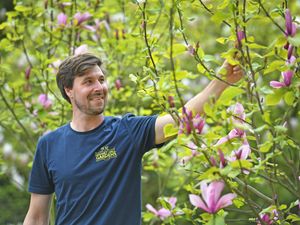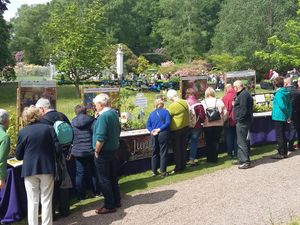Why Powis Castle is at the cutting hedge of garden upkeep
Cutting hedges at famous gardens can always be a tricky task, especially at Powis Castle.
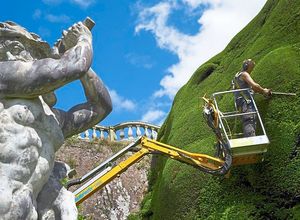
It has some of the largest castle hedges in the country, and takes 10 weeks to cut and up to 10 people to cut them.
In the garden there are almost 8,500 square meters of formal hedging and the 14 yew tumps and 14m-high top terrace hedge add a further 7,000 square meters to this.
Powis Castle head gardener David Swanton said: “It’s a huge task for us to get all the trimming done.
“Two gardeners spend six weeks trimming the box hedge and two more spend 12 weeks working on the yew. One gardener spends about 10 weeks in the air on this hydraulic cherry-picker getting all the high trimming done.”
It might sound like a mammoth task, but until relatively recently it took 10 men a full four months to clip all the box and yew hedges.
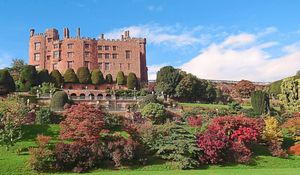
They used hand shears and balanced on very long ladders, tied together where necessary, to reach the top of the taller yews. Powered shears make all the difference and reduce the task considerably.
Powis’ famous yew tumps and hedges are almost 300 years old and their unusual shape tells the story of changing fashions in the horticultural world.
When they were originally planted in the 18th century, the yews were clipped into small, formal cones or pyramids.
However by the end of the century English landscape gardening, made popular by figures such as Capability Brown, had become fashionable and the yew hedges were allowed to grow naturally and become more ‘tree-like’.
This lasted until formal gardening made a resurgence in the Victorian era and the yews were once more clipped back into shape giving them the unusual structure that is still so striking to visitors today.
While the gardens at Powis Castle are stunning, the whole experience for visitors is steeped in the context of its importance in history.

The castle, Castell Powys in Welsh, is a medieval fortress and grand country mansion, sitting majestically near Welshpool.
It was built in the mid-13th century by a Welsh prince – Gruffudd ap Gwenwynwyn – wanting to establish his independence from his traditional enemies, the aggressive princes of Gwynedd.
This was in contrast to the other castles of North Wales, such as Caernarfon, Harlech and Conwy, which were built by the English to consolidate Edward I’s conquest of Wales.
By the late 13th century, Llywelyn ap Gruffudd of Gwynedd had established himself as Prince of Wales, and in 1274 he destroyed Powis Castle, forcing Gruffudd ap Gwenwynwyn into exile.
However, within three years Llywelyn’s principality had crumbled leaving Gruffudd of Powys to regain his lordship and rebuild the castle.
Gruffudd, his son and grandson had all died by 1309, and with no male heir, the castle and lordship passed to an heiress, Hawise, who married Sir John Charlton from Shropshire. In 1312, Hawise’s uncle, Gruffudd Fychan, attacked the castle in an attempt to claim the lordship but failed. Charlton repaired the damage and built two great drum towers, which you can still see, either side of the castle’s west entrance.
Restoration
Descendants of the Charltons continued as Lords of Powis for more than 100 years. However in 1421, lack of a male heir resulted in the castle and estate being divided between two daughters, Joyce and Joan, who had married Sir John Grey and Sir John Tiptoft.
Under the Tiptofts and their successor, Lord Dudley, the Outer Ward of the castle was neglected and needed considerable restoration.
Luckily, in the 1530s Edward Grey, Lord Powis, took possession of the whole castle and began a major re-building programme.
In 1578, Powis was leased to Sir Edward Herbert (c.1542–95) and Anne Parr (sister of Catherine Parr, the sixth wife of Henry VIII).
In the early 19th century Henrietta Herbert married Edward, the son of Robert Clive (Clive of India), and Edward was named Earl of Powis.
It is thanks to Edward Clive that Powis today has so many mementoes and fine art, many brought back from India. The house passed to the National Trust in 1952.
Volunteers ‘joust’ what we’re looking for
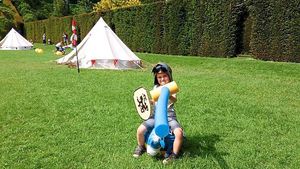
Powis Castle is no different to National Trust properties across the UK in that without the help of volunteers it simply would not be able to operate.
The attraction is alive with activities, especially during the summer months.
The school holidays have seen a host of imaginative chances for young people to let off steam – including medieval jousting for children on spacehoppers.
Paintings
A family garden trail has been created and there have been craft events, where youngsters can created their own coat of arms or a self portrait to replicate some of the grand paintings that hang within the walls of the castle.
An audio trail designed for families has also been brought in to help visitors make sense of what they see as they wander around.
All this activity is labour intensive. And while there is a dedicated team of employed staff, Powis Castle relies on the group of enthusiastic volunteers who love sharing the historic gem with visitors.
From Castle hosts and events assistants, to musicians and access drivers, the National Trust says it is always on the look out for people to help out.
Volunteer roles include:
Castle hosts, who welcome visitors and help them discover the stories the castle and collection has to tell
History and treasure explorers, who delve into Powis Castle’s past and share the information with visitors by helping to devise a programme of talks and tours
Ballroom musicians, who help bring to life the area of the castle that used to be a place of music and dance
Access drivers, to provide a shuttle service around the hilly property.
A National Trust spokesman said: “Volunteers are our lifeblood and without them we would not be able to operate.
“Powis Castle is a fantastic place, but it is the enthusiasm and knowledge of the statt and volunteers here that bring it to life and make it as real as possible for visitors.”
Fact box:
NAME: Powis Castle
DATE CONSTRUCTED: 1283
CLAIMS TO FAME: Princess Victoria, later to become Queen Victoria, visited the castle as a child when her mother took her to tour England and Wales in 1832.
It boasts incredible views from its distinctive galleried garden.
NUMBER OF VISITORS PER YEAR: 150,000 visitors each year


